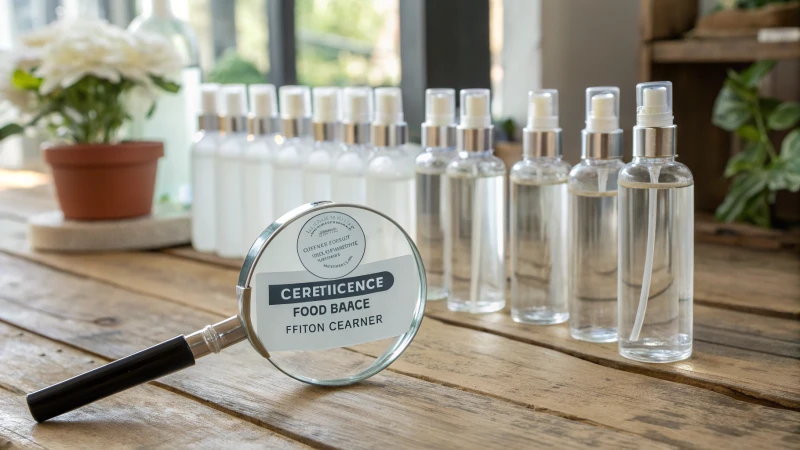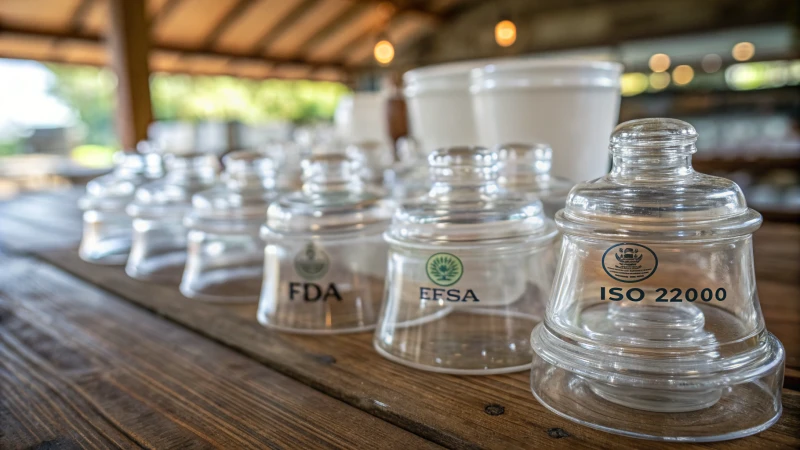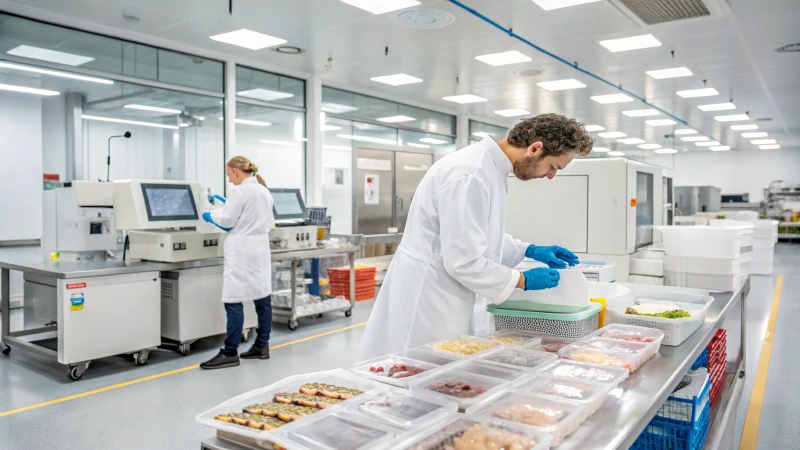
Have you ever wondered if those beautiful cosmetic glass bottles are safe enough for food-related use? It’s crucial to ensure they meet food-grade standards, especially if you’re like me and care about health and safety.
To confirm cosmetic glass bottles meet food-grade standards, check for compliance with regulations like FDA or EFSA. Look for certifications such as the Certificate of Conformity and perform migration tests to ensure no harmful chemicals leach from the glass.
When I first started sourcing packaging for my own products, the thought of harmful chemicals sneaking into my creams or oils kept me up at night. I quickly learned that beyond just checking the labels, diving into the nitty-gritty details of manufacturing processes and material sourcing was key. This journey not only eased my worries but also helped me build trust with my customers. Let me guide you through the steps to give you peace of mind too.
FDA guidelines ensure food-grade safety for glass bottles.正确
FDA guidelines set standards for materials in contact with food.
Migration tests are unnecessary for cosmetic glass bottles.假的
Migration tests ensure no harmful chemicals leach into contents.
What Certifications Should You Look for in Food-Grade Glass?
Navigating the labyrinth of food-grade glass certifications can feel overwhelming, especially when trying to ensure your products are truly safe. Let’s uncover the must-have certifications for peace of mind.
When choosing food-grade glass, prioritize certifications like FDA compliance, EFSA standards, and ISO 22000. These ensure your glass is free from harmful chemicals and safe for food contact.

Understanding Key Certifications
Deciphering the maze of food-grade glass1 certifications can be quite the task. Over the years, I’ve learned that certain certifications serve as my compass, guiding me toward the safest choices. Here’s what I discovered:
| Certification | Region | Purpose |
|---|---|---|
| FDA Compliance | United States | Ensures material safety for food contact. |
| EFSA Standards | Europe | Regulates chemicals in food contact items. |
| ISO 22000 | Global | Food safety management systems. |
FDA Compliance
In the U.S., the FDA is the gatekeeper of safety for materials that come into contact with food. I remember the first time I held a glass jar claiming to be FDA-approved—it was like a stamp of assurance. Always seek suppliers who can provide a Certificate of Compliance with these stringent FDA standards.
EFSA Standards
If you’re navigating the European market, EFSA standards are your best friend. They scrutinize risk assessments regarding food safety, ensuring your glass2 doesn’t leach harmful chemicals like lead or cadmium. I once had a supplier assure me of their EFSA compliance—seeing that certificate brought a wave of relief.
ISO 22000 Certification
This international standard is about more than just a badge; it’s a commitment to safe and consistent food safety management systems. Whenever I ask suppliers for their ISO 22000 certification, I feel confident knowing the glass production processes meet global safety norms.
Additional Important Certifications
While those are pivotal, there are other tests that further guarantee safety3:
- Migration Tests: Verifies that no harmful substances leach into foods—this is crucial if you’re handling heavy metals.
- 双酚 A-Free Certification: Especially relevant if coatings or resins are involved.
- GMP Certification: Ensures manufacturing follows Good Manufacturing Practices.
Verifying Certification Authenticity
In my journey, I’ve learned that not all that glitters is gold—fake certifications are unfortunately out there. Always verify authenticity by contacting issuing bodies or using verification tools4. Demand original certificates rather than copies, and consider third-party audits to confirm claims.
Regional Variations in Regulations
Regulations differ across borders, which is something I discovered when expanding my market reach. Understanding local requirements is vital if you plan to sell internationally. Do your homework and research local laws5 to ensure compliance worldwide.
By keeping these certifications and verification methods in mind, you can choose glass that not only aligns with international safety standards but also ensures the health and safety of end consumers—a peace of mind worth its weight in gold.
FDA compliance is required for all food-grade glass in the US.正确
FDA ensures materials are safe for food contact, crucial for US markets.
ISO 22000 only applies to European food safety standards.假的
ISO 22000 is a global standard for food safety management systems.
Why Are Migration Tests Crucial for Safety Compliance?
Ever wondered why your cereal box is more than just a pretty package?
Migration tests are essential for ensuring that packaging doesn’t transfer harmful chemicals to food, maintaining safety and compliance with regulations like FDA 和 EFSA.

Understanding Migration Tests
I remember my first day in the cosmetic packaging industry, feeling overwhelmed by the technical jargon around me. It was then I learned about migration tests—an unsung hero in ensuring our morning cereal or favorite lotion remains safe to use. Migration tests scrutinize whether substances from packaging materials sneak into the products we consume. By simulating everyday conditions, they offer a dependable safety net, ensuring compliance with rigorous standards.
Key Tests and Their Importance
-
Heavy Metals Migration Test: Picture this—you’re savoring your favorite snack, unaware it might contain traces of lead or cadmium from its packaging. Scary, right? This test is vital for detecting such metal leaching, which poses significant health threats.
-
Substance Migration Test: Ever notice that distinct plastic smell? Sometimes, that’s due to plasticizers from coatings migrating into the product. This test checks for those unwanted hitchhikers.
For precise results, certified labs like SGS6 or Intertek7 are indispensable partners.
How Migration Tests Protect Consumer Health
Imagine enjoying a meal knowing every bit is safe—migration tests make this possible. They confirm that food-grade packaging is devoid of harmful substances, aligning with FDA8 or EFSA9 standards.
- Health Assurance: They ensure no sneaky chemicals slip into our food chain.
- Regulatory Compliance: Helps us tick all the right boxes legally.
- Consumer Trust: Builds unwavering confidence in our product safety.
Best Practices for Conducting Migration Tests
Conducting these tests is an art and a science:
- Use Accredited Labs: Always go for labs with the right credentials.
- Consistent Testing: Regularly check new packaging batches to keep up with standards.
- Detailed Documentation: Thorough records are your best friend for audits and traceability.
Challenges and Considerations in Migration Testing
Navigating migration tests can be like solving a complex puzzle:
- Cost Implications: While vital, these tests can stretch budgets and timelines.
- Complexity: Understanding those chemical dances requires expertise.
- Variability: Global standards vary, demanding a broad knowledge base.
These hurdles highlight the necessity for strategic planning and collaboration with savvy partners.
| Test Type | Purpose | Importance |
|---|---|---|
| Heavy Metals Migration | Detects metal leaching into food/cosmetics | Protects against heavy metal poisoning |
| Substance Migration | Checks for chemical migration from coatings | Prevents exposure to harmful additives and contaminants |
In conclusion, while migration tests may seem daunting and resource-heavy, they are non-negotiable for guaranteeing the safety and compliance of food-grade packaging materials. They shield consumers and uphold trust in brand integrity through verified safety measures.
Heavy metals migration tests detect lead in packaging.正确
These tests check for metals like lead that can leach into food.
Migration tests are optional for regulatory compliance.假的
They are essential to ensure packaging meets safety standards.
How does the glass manufacturing process impact food-grade compliance?
Ever wondered how glass goes from raw material to your pantry shelf, holding your favorite foods safely?
The glass manufacturing process affects food-grade compliance by ensuring the purity and safety of the product. It involves choosing high-quality materials, following strict manufacturing standards, and applying non-toxic coatings.

Material Selection and Purity
I remember the first time I dove into the world of glass manufacturing. The sheer complexity of selecting the right raw materials was mind-boggling. High-quality food-grade glass, like borosilicate or lead-free glass, is vital because it resists corrosion and temperature changes while ensuring no harmful contaminants like lead or cadmium sneak in.
| 材料 | 益处 | Food-Grade Properties |
|---|---|---|
| Borosilicate | High heat resistance | Non-toxic, durable |
| Lead-free | Safe for food contact | No harmful leaching |
Learn more about borosilicate glass10
Manufacturing Standards and Quality Control
It feels like just yesterday when I realized how crucial maintaining strict manufacturing standards was to keep food-grade compliance in check. Implementing Good Manufacturing Practice (GMP) ensures cleanliness and consistency, something I’ve come to deeply appreciate after witnessing a few hiccups in production.
- Quality Assurance: Regular audits keep everything in line.
- Batch Consistency: Advanced traceability systems mitigate contamination risks.
Explore GMP standards for glass manufacturing11
Surface Treatments and Coatings
I once had a client who wanted a fancy, decorative glass bottle, and we had to make sure those coatings were non-toxic. It taught me the importance of using environmentally friendly treatments like siloxane-free coatings to prevent chemical migration.
- Non-Toxic Coatings: A must to keep products safe.
- Certification: Always ask for compliance test reports.
Understand non-toxic coating technologies12
Migration Testing and Certification
Migration tests are like the unsung heroes of glass manufacturing. Labs like SGS or Intertek conduct these tests to ensure no harmful substances leach into food—focusing on heavy metals and other chemicals.
| Test Type | Focus | Importance |
|---|---|---|
| Heavy Metals | Lead, Cadmium | Prevents toxic exposure |
| Substance Migration | Coatings, paints | Ensures product safety |
Find certified labs for migration testing13
Regional Regulations and Compliance
Navigating regional food safety standards can feel like jumping through hoops, but it’s essential for global market entry. Each region has its guidelines, with the FDA in the U.S. and EFSA in Europe setting different thresholds.
- Regional Standards: Understanding these is key.
- Global Market: Aligning with international standards opens doors.
Borosilicate glass is non-toxic and durable.正确
Borosilicate glass resists heat and corrosion, ensuring safety.
Lead-free glass is unsafe for food contact.假的
Lead-free glass is safe, preventing harmful leaching into food.
What Are the Risks of Non-Food-Grade Coatings and Paints?
Imagine discovering that the very paint you used could be leaching toxic chemicals into your food! It’s a chilling thought, isn’t it?
Non-food-grade coatings and paints can leach harmful chemicals, such as lead and cadmium, into food, posing significant health risks. Without the proper safety certifications, these materials increase the risk of contamination when they come into contact with consumables.

Health Hazards from Chemical Leaching
I remember the time I nearly overlooked the importance of using food-safe materials in my kitchen renovation. It was a wake-up call when I learned how non-food-grade coatings could leach hazardous chemicals like lead and cadmium, especially under heat or acidic conditions. Imagine cooking your favorite dish only to realize later that the beautiful paint on your kitchen shelves might have been a silent health hazard.
Common Hazardous Chemicals:
| Chemical | Potential Risks |
|---|---|
| Lead | Neurological damage |
| Cadmium | Kidney damage, cancer |
These contaminants can have long-term health effects, and as someone who values the well-being of my loved ones, I can’t stress enough how crucial it is to ensure our environments are safe.
Regulatory Non-Compliance
I’ve learned the hard way that using non-food-grade materials can lead to more than just health concerns—it can also mean facing regulatory violations. Organizations like the FDA14 和 EFSA enforce strict guidelines for food contact materials, and failing to comply can result in hefty legal penalties. It reminds me of a friend who faced significant business setbacks due to such oversights.
Impact on Brand Reputation
For businesses, the repercussions extend beyond legal fines. Consumers demand safe products, and any contamination incident can shatter trust. A colleague once shared how a single mistake led to a costly recall and a tarnished brand reputation. Ever since, I’ve been meticulous about sourcing verified, food-grade materials and maintaining stringent quality controls.
In essence, it’s about creating a safe space for ourselves and those who rely on us—whether it’s family at home or customers trusting in our products. By prioritizing safety and compliance, we not only protect health but also preserve trust and integrity.
Non-food-grade coatings can leach lead into food.正确
Lead in non-food-grade coatings can migrate into food, causing harm.
Using non-food-grade paints is compliant with FDA standards.假的
Non-food-grade paints violate FDA regulations for food contact safety.
结论
Ensure cosmetic glass bottles meet food-grade standards by verifying certifications, conducting migration tests, and confirming compliance with FDA or EFSA regulations to guarantee safety for food contact.
-
Learn about the various certifications needed for food-grade glass to ensure safety and compliance. ↩
-
Understand how FDA regulations apply to materials used for food contact, ensuring their safety. ↩
-
Explore why migration tests are crucial in verifying the safety of food-grade glass. ↩
-
Discover methods to check the authenticity of supplier-provided certifications. ↩
-
Gain insights into regional regulatory differences affecting food-grade glass compliance. ↩
-
SGS is a leader in migration testing services. Exploring their offerings can provide insight into available testing solutions. ↩
-
Intertek provides comprehensive testing services. Learn about their capabilities to ensure your packaging meets safety standards. ↩
-
Understanding FDA regulations is key to compliance. This link offers detailed guidelines on required migration testing. ↩
-
EFSA provides standards for food safety in Europe. Exploring these guidelines helps ensure your products meet EU requirements. ↩
-
Borosilicate glass is renowned for its heat resistance, making it ideal for high-end food packaging. ↩
-
GMP ensures consistent production quality, crucial for maintaining food-grade compliance. ↩
-
Non-toxic coatings prevent harmful leaching, ensuring safety in food-contact glassware. ↩
-
Certified labs conduct essential tests to ensure glass meets food safety standards. ↩
-
Learn about FDA guidelines to ensure compliance and safety for food-related products. ↩



